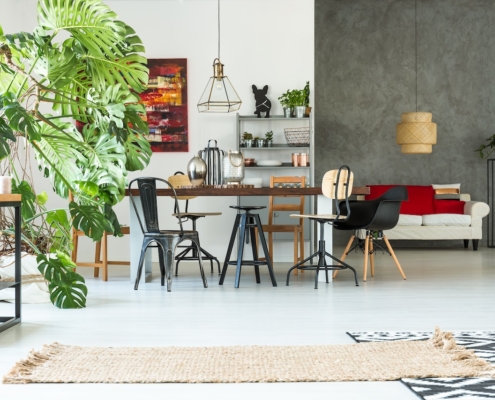Monstera Q&A with Plant Guru Justin Hancock
Houseplants have steadily grown more popular over the last couple of years, particularly with Millennials. It’s no surprise why—houseplants are inexpensive, readily available, and easy to acquire. They’re beautiful home décor items, but rather than just sitting around going out of style like plaid throw pillow, plants improve our health.
It doesn’t get more trendy than the Monstera plant. Read on for our Q&A with Costa Farms Horticulturist Justin Hancock.
How much light does Monstera need?
Lots of light. Inside, the more light you can give your monstera, the better. It’s a big plant, so it doesn’t come from the deeply shaded rain forest floor like a lot of our favorite houseplants (Chinese evergreen, Fittonia, Snake Plant, etc.). Monstera doesn’t necessarily like direct sun inside (direct afternoon sun can cause sunburn, which looks like bleached areas of the leaves), but it does want enough brightness that it casts a good shadow.
Do these plants like humidity?
Humidity definitely helps. Because monstera does hail from the tropics, it likes plenty of moisture in the air. Provide average to above-average relative humidity levels for optimal growth. Keep leaves lush and green by boosting humidity levels with a small humidifier, growing it in a bright bathroom, or grouping it with other plants.
How should Monstera be watered?
A lot of folks find watering plants is easiest when we come up with a regular schedule—once a week, for example. And while your monstera should grow fairly consistently, different factors can cause it to push out new leaves faster—or take a break and slow down. This affects the amount of water it uses (the faster it grows, the more water it drinks). You’ll find your plant will stay healthiest if you check for water regularly and only provide moisture when needed, rather than splashing on more H2O regardless if the potting mix is wet or dry.
Can Monstera be overwatered?
Yes! Too much water actually kills more houseplants per year than any other single cause. Monstera is no exception. Because, as it grows, it’s used to forming lots of aerial roots that cling onto tree trunks, the roots tend to rot if they stay wet and soggy. Let the top inch or two of the potting mix dry between waterings, and if in doubt, it’s better to keep it a little too dry than a little too wet. And if you have a saucer or drip tray at the bottom of the pot, don’t let water sit in there for more than 45 minutes or so — if the pot is standing in water for longer periods than that, the roots can start drowning.

How much nutrition does this plant need?
For best growth, you will want to feed your Monstera. Think of it like this: When growing a plant in a pot, that soil provides all the nutrition the plant gets. Nature doesn’t supply the constant cycle of fresh nutrients. So fertilizing your monstera ensures healthy growth. You can feed it as little as once a year (in spring) with a an organic liquid fertilizer such as Indoor!, or as often as the directions on the fertilizer package recommend. It all depends on how much and how fast you want your Monstera to grow.
When’s the right time to repot a Monstera? Or does Monstera even need repotting?
No plant truly likes being rootbound, and Monstera does best when roots get more room as they fill the pot. So give your plant a larger container when you see roots begin to circle the inside of the pot. Select a pot that’s 2 to 4 inches wider than the container it was in. Don’t jump to a pot that’s dramatically larger because it can lead to watering issues.
What does it mean if the leaves turn yellow and start dropping?
Yellowing leaves are kind of like the upset stomach of the gardening world—the one symptom could come from any number of causes. Watch for drafts: Blasts of hot or cold air, such as being next to an exterior door or heating/cooling vent, can cause the leaves to go yellow and drop prematurely. Overwatering can also cause leaves to go yellow. In general, stress can also cause Monstera to yellow some leaves, so you don’t necessarily need to be alarmed if you see it drop a leaf or two right after you bright it home from the nursery (or unpack it if you purchased it online).

Is Monstera a bush or a vine or what?
Monstera is a large plant, which when young, looks bushy. As it grows, it becomes vine-like. If you want yours to produce huge leaves (and who doesn’t?!), help it grow upright on a strong, sturdy structure, such as a wood or moss-filled pole (totem). I’ve also seen Monstera supported on a decorative chain hung from the ceiling.
Can the leaves be cut off without hurting the plant?
Yes! Don’t be afraid to cut an older leaf or two to decorate for a dinner party or show off to friends. Monstera are evergreen plants—so they keep their leaves all year. But, individual leaves do fade and will eventually drop from old age. If you’re going to cut, it’s best for the plant to cut the oldest leaves.
About the Author

Passionate about plants only begins to describe Costa Farms Garden Guru Justin Hancock. A lover of houseplants, tropicals, annuals, and perennials, Justin has a wealth of experience gardening all the way from Northern Minnesota to Miami. At Costa Farms, you’ll find Justin running between research and development, marketing, and everywhere in between!
Espoma Products for Monsteras




